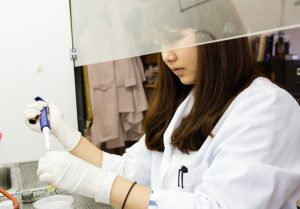
We don’t know if nanoparticles are yummy. Neither do we know if they are safe to eat.
Researchers at the University of Missouri are investigating the toxicity of nanoparticles on our bodies and a detection method to be able to identify nanoparticles in our food.
The research is coordinated by Mengshi Lin and Azlin Mustapha, associate professors of food science at the College of Agriculture, Food and Natural Resources. The project is funded with a grant from the United States Department of Agriculture.

“There are more than 1,000 products on the market containing nanoparticles,” Lin said. “This is a concern because we do not know the toxicity of the nanoparticles. Our goal is to detect and identify these nanoparticles in food and food products as soon as possible.”
A nanoparticle is millions of times smaller than a strand of human hair or the period at the end of this sentence. Nanoparticles are defined as the smallest unit that can still behave as a whole entity in terms of properties and transport, according to nanogloss.com. Because they are so small, nanoparticles can go places in the body other particles can’t.
Nano Doughnuts?

Nanoparticles are increasingly turning up in foods. CNN decided to test doughnuts from a popular chain after learning that the titanium dioxide used as a coloring in the powdered sugar coating likely contained nano-sized particles. The confections did contain the particles.
Nanoparticles are thought to have the potential to revolutionize the food industry – from enabling the production of creamy liquids that contain no fat, to enhancing flavors, improving supplement delivery, providing brighter colors, keeping food fresh longer, or indicating when it spoils.
Not Just Food – Packaging, Too
The main focus of the MU research is the toxicity of nanoparticles when ingested. If used in food packaging, like plastic containers and wrapping, Mustapha asks, do the nanoparticles release into the food in the microwave? Do nanoparticles escape from packaging into your food? If so, what are the effects on intestinal cells?

It is believed that when ingested, nanoparticles pass into the blood and lymph system, where they circulate through the body and reach potentially sensitive sites such as bone marrow, lymph nodes, the spleen, the brain, the liver and the heart.
Lin’s main focus is to develop a way to detect nanoparticles in foods and food packaging. Zhong Zhang, a food science graduate student, is researching a way to track and detect silver nanoparticle contamination on pears and recently published his results in the Journal of Agricultural and Food Chemistry.
In fall 2011, two master’s students started work on new research projects. Ami Yoo is focusing on effects of zinc oxide and silver nanoparticles on natural human intestinal bacterial cells and Xiaomo Mao is studying the toxicity of the same nanoparticles on cells lining the human intestines.